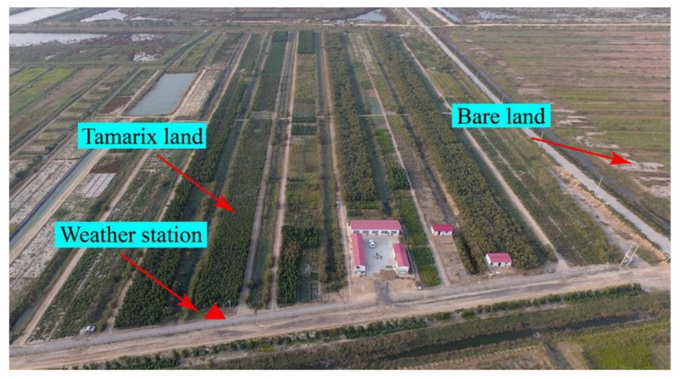Soil salinization,shallow saline groundwater level and lack of fresh water resource are the main limitation factors for the agriculture and vegetation construction in the costal saline region of North China. However, it is difficult to meet the needs of green development of saline land with the traditional saline land reclamation measures based on the groundwater regulation engineering and salt leaching with fresh water. We should change the ways of saline land utilization. Take the saline water and salt halophyte as important resources, to realize the sustainable development and utilization of the saline land. The research group of Professor Liu xiaojing had a systemic research for the saline soil, saline water and halophytes on the coastal regions of North China, and made some progress.
Halophytes are the main species of vegetation construction in coastal saline land. The researchers had focused on the resource utilization of halophytes, they had studied the salt tolerance and fruit production of the tomato grafted onto Lycium chinense, the adaptability difference of Suaeda salsa and Suaeda salsa in saline, alkali and drought environment, the water balance of Tamarix plantation, this studies would provid theoretical and technical support for agriculture and vegetation construction in saline land.
Wolfberry (Lycium. chinense) is a native halophyte that can grow in heavy saline soil of coastal saline soil (soil salt content more than 5?g?kg-1) and as a rootstock it could improve the salt resistance of the scion. Tomato and wolfberry are both Solanaceae spices,whether the tomato plants grafted on the woody halophyte could adapt to the coastal saline soil remained unknown. In the study by Dr Feng Xiaohui, self-rooted tomato seedlings and tomato scions grafted onto wolfberry (L. chinense) rootstock that were planted in saline soil were studied. The result indicated that the growth and fruit yield of the tomato grafted on wolfberry were reduced but the union of tomato and wolfberry was not sensitive to salt stress. The growth and fruit yield of the grafted tomato plants were limited by the thinner woody stem. The result suggested that tomato grafting on wolfberry was a feasible way for tomato fruit production in the coastal saline land of north China.
Suaeda glauca and Suaeda salsa are annual chenopod herbs that grow well in saline-alkali lands, and they share a number of morphological and physiological traits. We found that the natural distributions of these two halophytes were regionally heterogeneous in the saltmarsh of the Bohai coast, China. By the study of Dr Li Jinsong, habitat surveys and laboratory tests were conducted to examine the adaptability of S. glauca and S. salsa in variable environments. The result indicated that S. salsa was more tolerant to drought and salt stresses than S. glauca but less tolerant to alkalinity. The resistance variation between the two species was mainly due to their root adaptability and the potential cations regulation. Moreover, our study suggests that S. salsa is an optimal species for the artificial revegetation in high saline land, while S. glauca is more adaptable to alkali land.
As a halophytic species, Tamarix (Tamarix chinensis) can be used for saline soil rehabilitation in China. However, whether water resources in saline soil can support the construction of Tamarix vegetation is still unknown. Dr Chen Huanyu had measured the transpiration of Tamarix for 3 years using sap flow and the evaporation for 1 year using a micro-lysimeter in Tamarix land. The result indicated that planting Tamarix in coastal saline soil was feasible for the reclamation and rehabilitation of saline soil. In the dry year (2017), the consumption of evapotranspiration exceeded the precipitation. The inverse occurred in the normal year (2016) and wet year (2018). Taken together, our findings showed that the water resources in the coastal saline soil of China could tolerate vegetation construction and laid a strong foundation for saline soil rehabilitation.
These researches were supported by the National Natural Science Foundation of China (51809260), Key Research and Development Program of Hebei Province (18226803D), Key Deployment Project of the Chinese Academy of Sciences (KFZD-SW-1124). The Science and Technology Project of Hebei province, China (17227006D).

Fig 1 Infiltration process of melting saline ice water (S) and salt‐free ice water (F) in the coastal saline soil columns with different initial water contents (SW) and different initial bulk densities (BD)

Fig 2 The bird view of Haixing coastal saline land efficient utilization experimental base
Articles information
Kai Guo, Xiaojing Liu*. Effect of initial soil water content and bulk density on the infiltration and desalination of melting saline ice water in coastal saline soil, European Journal of Soil Science, 2019,70:1249-1266
https://doi.org/10.1111/ejss.12816
Xiaohui Feng,KaiGuo,Ce Yang,Jinsong Li,Huanyu Chen,Xiaojing Liu*,Growth and fruit production of tomato grafted onto wolfberry (Lycium chinense) rootstock in saline soil, Scientia Horticulturae, 2019,255:298-305
https://doi.org/10.1016/j.scienta.2019.05.028
Jingsong Li, Tabassum Hussain, Xiaohui Feng, Kai Guo, Huanyu Chen, CeYang, Xiaojing Liu*, Comparative study on the resistance of Suaeda glauca and Suaeda salsa to drought, salt, and alkali stresses, Ecological Engineering ,2019,140, 105593
https://doi.org/10.1016/j.ecoleng.2019.105593
Huanyu Chen, Ce Yang, Angyan Ren, Kai Guo, Xiaohui Feng, Jingsong Li, Xiaojing Liu*, Hongyong Sun*, Jianlin Wang. The Evapotranspiration of Tamarix and Its Response to Environmental Factors in Coastal Saline Land of China, Water, 2019, 11(11), 2273; https://doi.org/10.3390/w11112273


